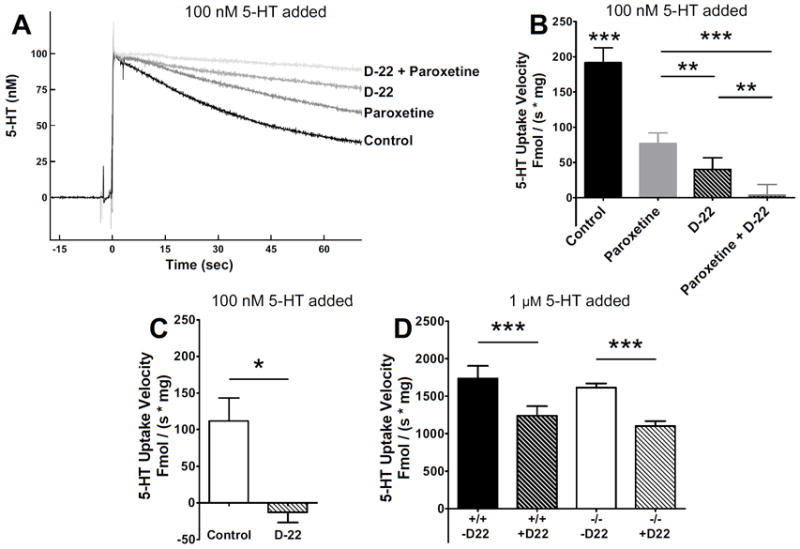Fig. 4.

Effects of paroxetine and D-22 in SERT wildtype and knockout synaptosomes. (A) Representative oxidation currents (converted to nM values) produced by adding 100 nM 5-HT to whole-brain synaptosomes in SERT wildtype mice treated with vehicle (control), 1 μM paroxetine, 10 μM D-22, or both drugs. For continuity and for convenience, vehicle and paroxetine traces are those illustrated in (Hagan, 2010), and were taken at the same time as the other two traces in this figure. (B) Initial clearance velocity was 192 ± 21 fmol / (s × mg) in control synaptosomes (n = 6), 77 ± 15 fmol / (s × mg) in paroxetine-treated synaptosomes (n = 6), 40 ± 16 fmol / (s × mg) in D-22 treated synaptosomes (n = 6), and 3 ± 15 fmol / (s × mg) in synaptosomes treated with both paroxetine and D-22 (n = 6). Data were analyzed by a one-way ANOVA with post hoc Newman-Keuls multiple comparisons tests comparing each pair of treatments. (C) Initial clearance rate of 100 nM 5-HT in SERT knockout synaptosomes was 112 ± 31 fmol / (s × mg) (n = 8). D-22 reduced clearance to -13 ± 14 fmol / (s × mg) (n = 3). Data were analyzed by an unpaired t-test. (D) Initial velocity taking up 1 μM 5-HT in control SERT wildtype and knockout synaptosomes, 1735 ± 129 (n = 6) and 1614 ± 55 fmol / (s × mg) (n = 4), respectively, was significantly reduced with D-22 to 1240 ± 126 fmol / (s × mg) in SERT wildtype (n = 6) and 1099 ± 68 fmol / (s × mg) in SERT knockout (n = 4). A two-way ANOVA revealed no significant effect of genotype, but drug effects on clearance were significant at p < 0.001. Data are expressed as mean ± SEM, *p < 0.05, **p < 0.01, ***p < 0.001. The significance level was set at p < 0.05.
